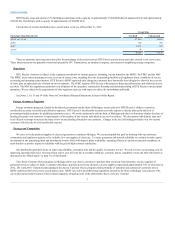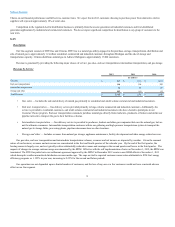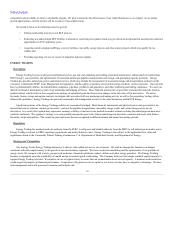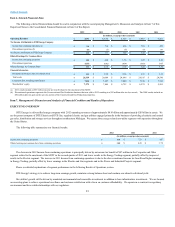DTE Energy 2012 Annual Report Download - page 19
Download and view the complete annual report
Please find page 19 of the 2012 DTE Energy annual report below. You can navigate through the pages in the report by either clicking on the pages listed below, or by using the keyword search tool below to find specific information within the annual report.
Table of Contents
We may also incur liabilities as a result of potential future requirements to address climate change issues. Proposals for voluntary initiatives and
mandatory controls are being discussed both in the United States and worldwide to reduce greenhouse gases such as carbon dioxide, a by-product of burning
fossil fuels. If increased regulation of greenhouse gas emissions are implemented, the operations of our fossil-fuel generation assets may be significantly
impacted. Since there can be no assurances that environmental costs may be recovered through the regulatory process, our financial performance may be
negatively impacted as a result of environmental matters.
Future environmental regulation of natural gas extraction techniques including hydraulic fracturing being discussed both at the United States federal level
and by some states may affect the profitability of natural gas extraction businesses which could affect demand for and profitability of our gas transportation
businesses.
Operation of a nuclear facility subjects us to risk. Ownership of an operating nuclear generating plant subjects us to significant additional risks. These
risks include, among others, plant security, environmental regulation and remediation, changes in federal nuclear regulation and operational factors that can
significantly impact the performance and cost of operating a nuclear facility. While we maintain insurance for various nuclear-related risks, there can be no
assurances that such insurance will be sufficient to cover our costs in the event of an accident or business interruption at our nuclear generating plant, which
may affect our financial performance.
The supply and/or price of energy commodities and/or related services may impact our financial results. We are dependent on coal for much of our
electrical generating capacity. Our access to natural gas supplies is critical to ensure reliability of service for our utility gas customers. Our non-utility
businesses, including our energy transportation business, are also dependent upon supplies and prices of energy commodities and services. Price fluctuations,
fuel supply disruptions and changes in transportation costs could have a negative impact on the amounts we charge our utility customers for electricity and
gas and on the profitability of our non-utility businesses. We have hedging strategies and regulatory recovery mechanisms in place to mitigate some of the
negative fluctuations in commodity supply prices in our utility and non-utility businesses, but there can be no assurances that our financial performance will
not be negatively impacted by price fluctuations. The price of energy also impacts the market for our non-utility businesses that compete with utilities and
alternative electric suppliers or provide energy transportation services.
The supply and/or price of other industrial raw and finished inputs and/or related services may impact our financial results . We are dependent on
supplies of certain commodities, such as copper and limestone, among others, and industrial materials and services in order to maintain day-to-day operations
and maintenance of our facilities. Price fluctuations or supply interruptions for these commodities and other items could have a negative impact on the
amounts we charge our customers for our utility products and on the profitability of our non-utility businesses.
Adverse changes in our credit ratings may negatively affect us. Regional and national economic conditions, increased scrutiny of the energy industry
and regulatory changes, as well as changes in our economic performance, could result in credit agencies reexamining our credit rating. While credit ratings
reflect the opinions of the credit agencies issuing such ratings and may not necessarily reflect actual performance, a downgrade in our credit rating below
investment grade could restrict or discontinue our ability to access capital markets and could result in an increase in our borrowing costs, a reduced level of
capital expenditures and could impact future earnings and cash flows. In addition, a reduction in our credit rating may require us to post collateral related to
various physical or financially settled contracts for the purchase of energy-related commodities, products and services, which could impact our liquidity.
Poor investment performance of pension and other postretirement benefit plan holdings and other factors impacting benefit plan costs could
unfavorably impact our liquidity and results of operations. Our costs of providing non-contributory defined benefit pension plans and other postretirement
benefit plans are dependent upon a number of factors, such as the rates of return on plan assets, the level of interest rates used to measure the required
minimum funding levels of the plans, future government regulation, and our required or voluntary contributions made to the plans. The performance of the
debt and equity markets affects the value of assets that are held in trust to satisfy future obligations under our plans. We have significant benefit obligations
and hold significant assets in trust to satisfy these obligations. These assets are subject to market fluctuations and will yield uncertain returns, which may fall
below our projected return rates. A decline in the market value of the pension and postretirement benefit plan assets will increase the funding requirements
under our pension and postretirement benefit plans if the actual asset returns do not recover these declines in the foreseeable future. Additionally, our pension
and postretirement benefit plan liabilities are sensitive to changes in interest rates. As interest rates decrease, the liabilities increase, resulting in increasing
benefit expense and funding requirements. Also, if future increases in pension and postretirement benefit costs as a result of reduced plan assets are not
recoverable from our utility customers, the results of operations and financial position of our company could be negatively affected. Without sustained growth
in the plan investments over time to increase the value of
17
























